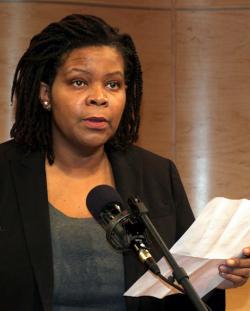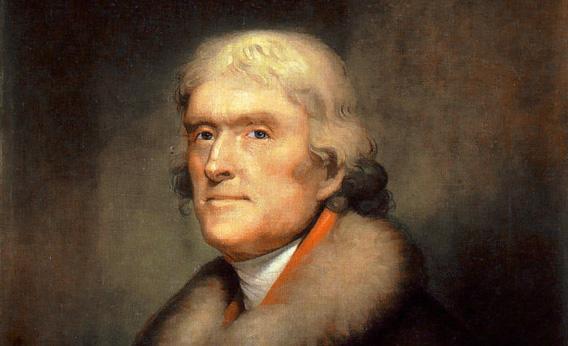Almost 20 years have passed since the publication of Jeffersonian Legacies, a collection of essays published on the occasion of the Founding Father’s 250th birthday that ushered in a new era of Jefferson scholarship. What were modern Americans to make, the book asked, of the 18th-century slaveholding patriarch who could not envision a multiracial America but who nonetheless authored America’s creed—a vision that has inspired people the world over? At the very least, one had to be, the book suggested, conflicted about the man.
Henry Wiencek is not at all conflicted. He loathes Thomas Jefferson. In Master of the Mountain: Thomas Jefferson and His Slaves, his attempted takedown of the man, the third president appears as a demonic figure warped one summer day by a sudden discovery that being a slaveholder could pay. I’ll detail how Wiencek arrives at his bizarre proof of a Jefferson who suddenly becomes Simon Legree, but I should say up front that this book fails as a work of scholarship. This is surprising. I favorably reviewed Wiencek’s book about George Washington, Imperfect God, and I admire The Hairstons: An American Family in Black and White. What happened with Master of the Mountain?
The book’s tone and presentation betray a journalistic obsession with “the scoop.” Getting the scoop can be the life’s blood of journalism. It does not work so well for writing history, which is not always (or almost ever, really) about discovering things previously unknown. This sensibility leads Weincek astray in a number of ways. To begin with, it compels him to write as if he had discovered, and was writing about, things that had not been discovered and written about before. In truth, all of the important stories in this book have been told by others.
There is nothing inherently wrong with recycling stories. All historians do, and that is to be expected. But Wiencek rarely adds insights to these recycled stories, and when he offers interpretations, they are usually wrong-headed. It often seems that he is ignoring all the things that have been written about Jefferson and slavery over the past 30 years, consigning it to a claim that “scholarly consensus” is that “Jefferson managed his plantations with a lenient hand.”. In fact, scholars have known, and written, for years about whipping at Monticello.
Wiencek’s primary scoop—upon which his thesis depends and his publisher is marketing this new history—is that he has discovered why Jefferson went from opposing slavery to enthusiastically supporting the institution. It happened, Wiencek says, in the summer of 1792:
As Jefferson was counting up the agricultural profits and losses of his plantation in a letter to President Washington in 1792, it occurred to him that there was a phenomenon he had perceived at Monticello but never actually measured. He proceeded to calculate it in a barely legible, scribbled note in the middle of a page, enclosed in brackets. What Jefferson set out clearly for the first time was that he was making a 4 percent profit every year on the birth of black children.
Of course, Weincek could not possibly know what “occurred to” Jefferson as he did his calculations. And note the reference to the “barely legible, scribbled note,” as if he had ferreted out a detail that only the most diligent of researchers would have found. He then quotes Jefferson: “I allow nothing for losses by death, but, on the contrary, shall presently take credit four per cent. per annum, for their increase over and above keeping up their own numbers.”
The problem with what Wiencek calls the “4 percent theorem” or “formula” is that Jefferson was not speaking about his slaves at Monticello—he was speaking about farms in Virginia generally. The quoted “four per cent” line is from his “Notes on Arthur Young’s Letter to George Washington,” written, while Jefferson was serving in Washington’s Cabinet, in response to a request for a comparison of free labor to enslaved labor. Jefferson, who could never resist an opportunity to count and compute, joined in to “calculate, in the Virginia way, the employment” of slave labor. When he speaks of allowing “nothing for losses by death,” he is explaining what variables are going into his calculations about how to determine the value of enslaved labor—not opining on any policy he had at Monticello. In a later letter to Washington, Jefferson noted that “being at such a distance from the country of which I wrote,” he utilized his own time-weakened memories of life in Virginia. “I therefore hazarded the calculation rather as an essay of the mode of calculating the profits of a Virginia estate, than as an operation which was to be ultimately relied on.”
Jefferson had no “4 percent theorem” or “formula.” This lawyer and lifelong slaveholder had no epiphany in 1792, approaching age 50, that the babies of enslaved women increased his capital. Jefferson’s thoughts about slavery cannot be treated in such a reductive manner.
We can come down from Wiencek’s version of high theory to see in another context how he reasons and solves problems. He suggests that Jefferson purchased collars—iron spiked vises—for slaves. Follow Wiencek’s logic and note the incredible inferential leaps required to link these disparate occurrences into a chain: Jefferson’s father, Peter, advertised for a runaway slave (in 1751) who was wearing an iron collar; Jefferson must have seen enslaved people being collared when he was growing up; while in France in the 1780s, Jefferson wrote to Nicholas Lewis, the manager of his farms, telling him to use “extraordinary exertions”; and then—“the manager’s expense accounts in 1791 include a line item for the purchase of ‘collars.’” Wiencek’s endnote explains that he had “at first” thought the reference was to “horse collars.” That view changed after Wiencek noticed that Jefferson wrote “leather collars” or “horse collars” and “Lewis would have been similarly specific.” Therefore, enslaved people at Monticello must have been put in iron collars.
In fact, Monticello had a blacksmith shop that supplied the surrounding community with iron works. Why, then, would Lewis have to buy iron slave-collars from an outside source? And Christa Dierksheide, a researcher at Monticello, says that the man from whom Lewis bought the collars was not a blacksmith. He was a local tenant farmer, and would have used collars for cattle and horses on his farm. Wiencek should have considered this.
Wiencek also excoriates Jefferson for his handling of Tadeusz Kosciusko’s will. Kosciusko, the Polish patriot and supporter of the American Revolution, drafted a will in 1798 that included a bequest of funds to purchase and emancipate slaves, naming Jefferson as executor. According to Wiencek, the matter was crystal clear, as it must be if he wants to present yet another example of Jefferson’s implacable evil: “Kosciusko had made him the executor of the will, so Jefferson had a legal duty, as well as a personal obligation to his deceased friend, to carry out the terms of the document.” Jefferson “refused” to act.
Jefferson’s legal duties, however, were inextricably paired with potential liabilities of which Wiencek seems wholly unaware. Long story short: Kosciusko screwed up. After the 1798 will, Kosciusko wrote three more wills, the last one in 1817, the year he died. In the one written in 1816, he explicitly revoked all his previous wills and made bequests to other people in Europe. He made no mention of excepting the American will from this revocation, though a reference he made in a letter to Jefferson in 1817 indicates he thought his 1798 bequest still valid. Jefferson may have believed that too. But he also knew that whether Kosciusko’s statement revived the bequest was a legal question that would have to be answered in court—a high court, no doubt, given the large sums of money involved. Upon learning what Kosciusko had done, and that there were competing wills, Jefferson, in his mid-70s, transferred his duties (and, this is important, his potential financial exposure) to a court that then appointed an administrator.
As Jefferson knew, this was a litigation disaster waiting to happen. Indeed, the case became an American version of Bleak House’s Jarndyce v. Jarndyce, dragging on from the 1820s to final resolution before the Supreme Court in 1852, which declared that the 1816 will had, in fact, revoked the 1798 bequest. Using money from the bequest to free slaves when others had potentially valid claims on the estate would have been extremely risky. If Jefferson had done that and it was later determined that the claimants had a right to the funds, he could be liable for repayment. Once he gave his powers over to the court, Jefferson’s responsibilities—and the threat of financial entanglement to his already precarious financial position—were over.
Wiencek, apparently not attuned to the workings of law and the tendencies of many lawyers toward paranoia and risk aversion, simply will not consider the notion that Jefferson could have had other good reasons for resigning as executor. Wiencek recounts some of these details, but analyzes them all from the perspective of the powers Jefferson had, without considering the corresponding vulnerabilities inherent to the position of executor or administrator of a will. That is because Wiencek’s all-powerful “bad Jefferson” can never be vulnerable or apprehensive. Everything he does is in service of getting his 4 percent every year, which Wiencek does not even demonstrate he ever got.

Photograph by David Shankbone/Wikimedia Commons.
I could go on. Suffice it to say that the problems with Master of the Mountain are too numerous to allow it to be taken seriously as a book that tells us anything new about Thomas Jefferson and slavery, and what it does say is too often wrong. It is, instead, a book about Henry Wiencek—with Jefferson, enslaved people, and the mountain thrown in for scenery. As he seeks to destroy Jefferson, Wiencek seeks to put himself in the place of the “Master of the Mountain” and become the true protector of the enslaved people of Monticello. He injects himself into the narrative, touring Monticello, walking the grounds that Jefferson walked, cataloging the injustices to the enslaved people as if they had finally, after all these years, found a champion.
But as they so often do in life, a stray comment betrays true feelings. Wiencek tells the story of Peter Fossett, a member of the favored Hemings family, who spoke with fondness of the blue suit and watch that his father and free grandmother, Mary Hemings, gave to him. “That Peter could hold on to those precious items,” Wiencek writes, “without having them stolen and himself beaten by the slave boys or local whites reveals the power of the invisible zone of protection that enfolded him.” What must Wiencek really think of those enslaved at Monticello? In his view, the only thing stopping enslaved people from beating one another up and stealing from one another was the protection provided by a white man who fashioned himself as a benevolent patriarch. It seems the enslaved people of Monticello, in death as in life, can’t catch a break.
